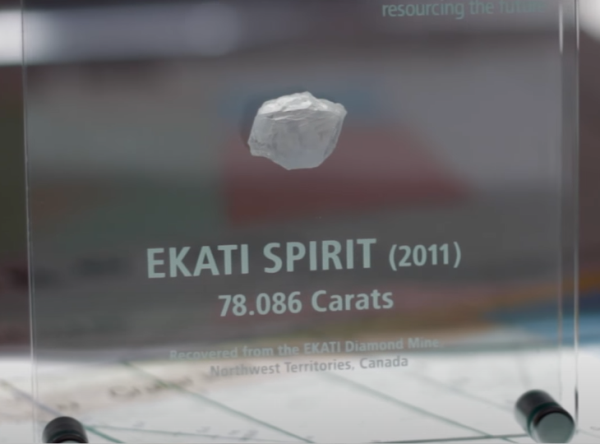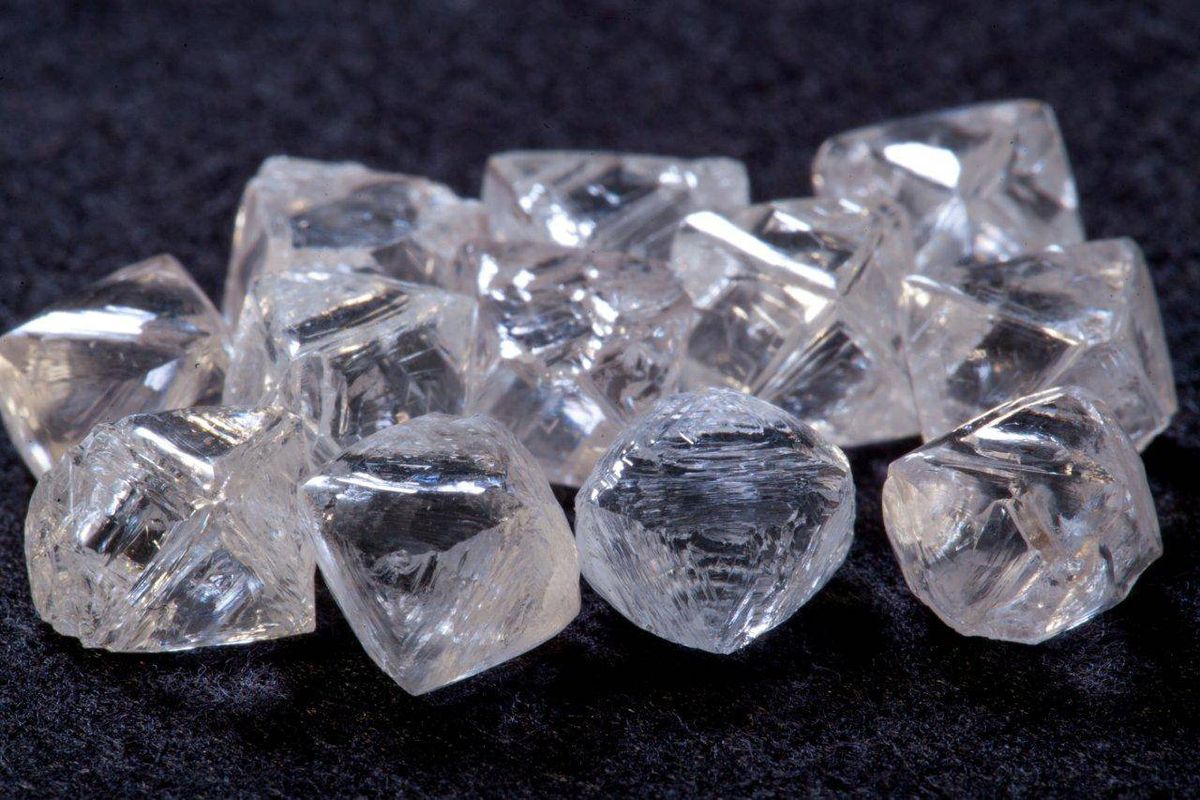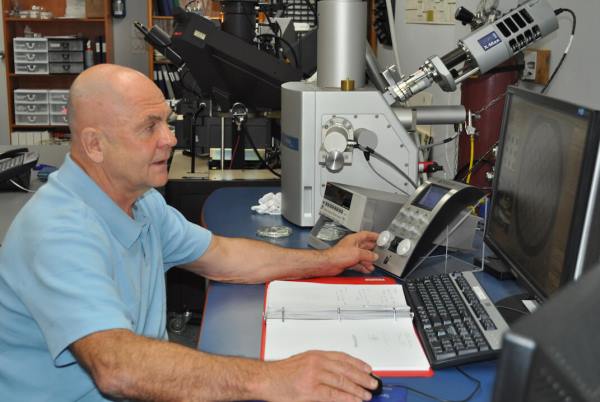GEM OF A GUY: CHUCK FIPKE – "Canada’s most decorated discoverer of diamonds – and one of the most renowned geologists in the world – relishes good friends, good food and wine, good racehorses and of course, good, mineral-rich ground... Chuck recently [2011] put his money where the microscope is." (Source)
Disseminated on behalf of Arctic Star Exploration Corp. and Zimtu Capital Corp.
First, in 1991, Chuck Fipke co-discovered what became North America‘s first diamond mine: Ekati. Then, a year later in 1992, Buddy Doyle co-discovered the Diavik Diamond Mine in the same Lac de Gras Kimberlite Field in the Northwest Territories, Canada. Back then, both used different methods of exploration to make their respective multi-billion-dollar diamond finds. Now, both still-hungry prospectors, again using different methods of scientific research, found indications pointing to the existence of large diamonds at Arctic Star Exploration Corp.‘s recently discovered diamond-bearing Sequoia Kimberlite Complex. As it‘s highly unlikely to find a large diamond in the very first drill holes, today‘s news from Arctic Star is arguably as good as it gets.
Thanks to the discoveries of Ekati and Diavik, and later other diamond mines in NWT, Nunavut, Saskatchewan, Ontario, and Quebec, Canada was the world‘s third largest producer of rough diamonds by value and by volume in 2019. Large gem-quality diamonds have been found in NWT: In 2011, the 78 carat Ekati Spirit was unearthed at the Ekati Mine. At Diavik, the 187.7 carat Foxfire was found in 2015, and three years later a 552 carat yellow diamond.

Full size / "Chuck is a leading expert on diamond indicator mineral geochemistry. He holds patents in several countries for mineral processing techniques. In 1995, he published the first guide to diamond exploration using indicator mineral geochemistry. And his lab, in my mind, has become one of the best in the world actually. A lot of the equipment you can´t find anywhere else. He´s keen today as he was in the past." (Source)
Diamond exploration today involves much more than just geophysics and drilling – it largely depends on scientific research and experience, not to mention luck. When it comes to diamond exploration, Chuck Fipke is one of the world´s most successful and prominent authorities: The Canadian geologist (born 1946) is a prospector and scientist by heart and is known for having discovered the multi-billion-dollar Ekati Diamond Mine around Lac de Gras in Canada´s Northwest Territories – the same kimberlite field where Arctic Star has recently discovered the diamondiferous Sequoia Kimberlite.
Chuck Fipke‘s C.F. Mineral Research Ltd. laboratory in Kelowna, BC, not only uses state-of-the-art equipment but also one of the world‘s largest databases of diamond indicator and inclusion minerals from deposits all over the planet. So, when Chuck says that the abundance of certain large diamond indicator and inclusion minerals recovered from three Sequoia drill hole samples exceeds that of any of the diamond-bearing (lherzolitic) kimberlites in C.F. Mineral´s database, you can rest assured that Artic Star believes to be onto something big and that the company is already planning the next phase of exploration in its quest to find those large diamonds at Sequoia.

Arctic Star‘s CEO, Pat Power, will be discussing the significance of today‘s news-release at 10:30am PT today. Click here to join!
Today‘s news-release from Arctic Star:
Sequoia Kimberlite Complex’s Indicator Mineral Chemistry Points to Large Diamonds, Diagras Project, NWT
Highlights
• Diamond chemistry reported from Chuck Fipke using C.F. Minerals research lab confirms identical chemistry to those found in large diamonds from Ekati, Letseng, Lucara, and Victor.
• Early Caustic Fusion diamond results are also consistent with large diamond population.
• Indicator and Diamond results demonstrate that different kimberlite types have sampled different parts of the lithosphere and will have different grades and diamonds.
September 9th, 2021 - Vancouver, British Columbia – Arctic Star Exploration Corp. (“Arctic Star” or the “Company”) (TSXV: ADD) (Frankfurt: 82A2) (WKN: A2DFY5) (OTC: ASDZF) is pleased to announce that it has received diamond indictor mineral results and an interpretation of these from Chuck Fipke for the first hole into the Sequoia Kimberlite complex. The results demonstrate the existence of a number of indicator types that occur with diamonds and strongly suggest the presence of diamonds. Furthermore, indicator minerals of identical multi-element chemistry to those found as inclusions in large >50 carat diamonds world-wide are abundant. The indicators from different kimberlite types are starkly different. These observations are in agreement with the caustic diamond results, which show the different kimberlite types have different stone/kg counts and also hints at a coarse diamond distribution. Ultimately a bulk sample will be required to confirm the diamond distribution and this is the normal path of progress for diamond exploration. Prior to this a drill program defining the volumes of the different kimberlite types and their caustic fusion diamond distribution is planned for spring 2022.
Samples of kimberlite core were sent to C.F. Mineral Research Ltd. in Kelowna, BC for indicator mineral analysis. C.F. Minerals is a global-leading kimberlite and diamond analytical research facility lead by Chuck Fipke, one of the founders of the Ekati diamond mine. At the lab, the samples were lightly crushed with heavy minerals separated by dense media gravity methods. Oxides and silicates are split using magnetic separation. Candidate diamond indicator minerals are selected by a minerologist, mounted, and scanned for chemical composition using a scanning electron microscope (SEM). Mineral grains that “light up” under different element scans are mapped and then assayed by electon microprobe. The microprobe results are presented here.
Mineral grains that grow concurrently while touching or within diamonds have distinct chemistry and are diagnostic of the presence diamonds and also of the rock types that host the diamonds at great depths.
Readers should note the following deep mantle, high pressure rock types associated with diamond mineralization that are noted in this release.
Lherzolite: Garnet, Clinopyroxene, and Olivine. (certain types host >50carat diamonds)
Harzburgite: Garnet (low calcium, high chrome), Orthopyroxene, and Olivine. (Source of the desirable “G10” garnets and P type diamonds.)
Chromite: Harzburgite: A garnet poor, Chromite rich variety of above.
Eclogite: Garnet and Pyroxene. Source of E Type diamonds
The samples analyzed thus far are from the Sequoia kimberlite, hole DG-2021-04 located in the geographical center of the complex. One sample from the interval 51m to 89m (5.1kg) from the Coherent Kimberlite (“CK”), another sample from the interval 105m to 136m (5.1kg) logged as Volcanoclasitc Kimberlite transitional (“VKt”) into Coherent Kimberlite and a sample from the interval 136m to 150m (5.3kg) logged as Volcanoclastic Kimberlite (“VK”).
Chuck Fipke reports:
“The two Volcanoclastic samples are dominated by diamond inclusion minerals (high calcium G10 garnets (classifying as G10-2 and G10-3) found in Lherzolite, (G11) garnets, and diamond inclusions (CP5) clinopyroxenes that have been found as inclusions in big diamonds ranging from 52 to 102 carat from the Ekati diamond mine (coined „Di$“) as well as chromite rich harzburgite containing diamond inclusion chromites and orthopyroxenes. Current research suggests these larger diamonds come from great depths >400km.
The diamond inclusion minerals from lherzolite (DI$, CP5 G9/G11 indicators mentioned above) found in Sequoia are identical to those present in Letseng (In Lesotho), Victor (In Canada), and Lucara’s Karowe Mine (Botswana). These kimberlites are typically lower grade but contain very large high-quality diamonds routinely recovered during run-of-mine operations. This is based on analysis of inclusions from over 335 diamonds from these sources as well as Ekati’s large stones. The classification scheme relies on the multi-element analysis of the Sequoia indicator minerals having the same chemical composition as the indicators from known large diamond sources.
As well as passing through and sampling of lherzolite, the Sequoia kimberlite has sampled diamond bearing chromite harzburgite as evidence by the abundant 99 diamond inclusion composition chromites and 45 diamond inclusion orthopyroxenes present. These additional mineralogies could account for any smaller diamonds recovered. The two Volcanoclastic samples have relatively few eclogitic type garnets which can also be associated with diamond mineralization.
In contrast to the VK samples, the CK sample from 51 to 89 meters has abundant Group1 eclogitic garnets where the EMP yields 51 diamond inclusion eclogite grains. This sample also has the large diamond inclusion llerzolite minerals and the subordinate diamond bearing (low calcium-high chrome G10-7 and G10-9) pyrope garnet bearing harzburgite not present in the VK as well as chromite harzburgite present in the VK. A total of 80 diamond inclusion composition chromites and 10 diamond inclusion olivines were recovered from the chromite harzburgite.
It is also worthy to note that the overall abundance of the lherzolite (DI$, CP5 G9/G11 indicators) large diamond inclusion minerals recovered from the three Sequoia DG 2021-04 drill hole samples exceeds, per sample weight, that of any of the diamond bearing (lherzolitic) kimberlites in the C.F. Minerals database. These results indicate that large diamonds should be present if sufficiently large tonnages of this kimberlite are processed by methodology that recovers large diamonds. The presence of abundant diamond inclusion chromites and orthopyroxenes, as well as abundant diamond inclusion Group 1 eclogitic garnets, and subordinate low calcium-high chrome G10 garnets and diamond inclusion olivines indicate smaller potentially commercial diamonds may also be present.”
Buddy Doyle, VP Exploration for Arctic Star commented, “It is interesting that the caustic fusion microdiamond results also hint at a coarser diamond distribution. Table 1 shows the published results from the Jack Pine Kimberlite which makes up the southern 200m of the Sequoia complex, and the diamond results received from Arctic Star’s caustic fusion results from the center of Sequoia. These results, plotted on a size vs frequency plot (figure 1), clearly show a coarser diamond population for our recent Sequoia results. Table 3 shows the diamond counts from the different rock types from this drill hole. Like the indicators there seems distinct populations of diamonds from the different rock types. The company has decided to send the remaining half-split core of Sequoia to the lab to get more diamond results to help construct a more robust curve of the size distribution. It is likely we will need more samples than this to get a good view of the grade and the presence of the larger stones. Given the evidence presented by Chuck Fipkes’s analysis, if big diamonds are proven to be there it will be worth it. “

Full size / Figure 1 Size Frequency plot: Diamond size distribution. Sequoia in Orange, Jack Pine in Green. The Sequoia samples appear to have two populations of diamonds, and clearly has a higher frequency of larger diamonds than the Jack Pine sample. Figure 1 also depicts possible trajectories for the Sequoia diamond distribution. For this small sample of less than 300kg, the spread of trajectories is large. Further caustic fusion samples would narrow down this spread. It is desirable to have several commercial size stones from caustic fusion before predicting grade and size distribution with great accuracy.
Mr. Buddy Doyle further commented, “The next step for the Sequoia kimberlite complex is to do more small diameter drilling to further understand the geology, we already have diamond and indicator mineral data that suggests the different types of kimberlite in this complex have different diamond populations and grade. Drilling this body at 100m then where needed 50m centers and conduct caustic fusion analysis would achieve this and fill out the size frequency curve shown in figure 1. Should this prove encouraging and confirm the possibility of large diamonds, a bulk sample using either a large diameter drill rig or underground bulk sampling would be the next step. Which on completion would allow for a feasibility study. Given that there are two operating diamond mines within 35km Arctic Star could also seek out scenarios involving these, along the way.”
Table 3 shows the geology of drill hole DG 2021 04 and each individual rock types Caustic fusion diamond count for stones over 105 microns, illustrating the diamond count differences, which will be reflected in the commercial grade. The next round of work will outline the distribution of these rock types while continuing to make a more robust size frequency curve.
Table 3 demonstrates that the different kimberlite types have variable diamond counts. The volcanoclastic rock types have significantly less diamonds than the cohernet kimberlite rock type. (Results from Caustic fusion SRC laboraties and independent laboratory see NR dated July 6th 2021 for details).
Analysis of mineral indicator minerals from the other kimberlites is awaited. The rest of the caustic fusion diamond results from the other kimberlite discoveries are expected before the end of this week. The second round of Sequoia results where we have sampled the other half of drill holes DG 2021 04 and 05 should also be in the next weeks.
Qualified Person
The Qualified Person for this news release is Buddy Doyle, AUSIMM, a Geologist with over 35 years of experience in diamond exploration, discovery, and evaluation. A Qualified Person under the provisions of the National Instrument 43-101.
Neither the TSX Venture Exchange nor its Regulation Services Provider (as that term is defined in the policies of the TSX Venture Exchange) accepts responsibility for the adequacy or accuracy of this release. Cautionary Statement Regarding “Forward-Looking” Information: This news release contains “forward-looking statements” including but not limited to statements with respect to Arctic Star’s plans, the estimation of a mineral resource and the success of exploration activities. In this release it is not certain if the kimberlite discovered will be economic or not as this depends on many factors. Forward-looking statements, while based on management’s best estimates and assumptions, are subject to risks and uncertainties that may cause actual results to be materially different from those expressed or implied by such forward-looking statements. There can be no assurance that such statements will prove to be accurate, as actual results and future events could differ materially from those anticipated in such statements. Factors that could affect our plans include our potential inability to raise funds as intended, and in such event we may require all funds raised, if any, to be used for working capital rather than the intended uses as outlined. Accordingly, readers should not place undue reliance on forwardâ€looking statements. Arctic Star undertakes no obligation or responsibility to update forwardâ€looking statements, except as required by law.

Full size / "Chuck Fipke is a breed unto himself: an explorer and innovator, a scientist and entrepreneur." (Source)
According to "Fipke still looking for new diamond finds" (2014):
"If anyone can revive the Canadian diamond industry, Mr. Fipke is a likely candidate. His life reads like a thriller novel, and indeed, a book has been written about his adventures. He and his partner, geologist Stewart Blusson, famously searched the Arctic tundra for years before proving there were commercial diamonds in the Lac de Gras region of the Northwest Territories. Along the way, Mr. Fipke has fended off lions, a bout of malaria and warrior tribes in exotic locales."
Click above player or here to watch “Charles Fipke Tribute Video“ (2013): "Chuck´s discovery of diamonds in the NWT is one amazing story – one built on good science, courage, tenacity, intrigue, and determination." (Source)
According to Wikipedia:
"Upon graduation, Fipke worked for companies such as Kennecott Copper and Cominco, performing mineral explorations in locations such as Papua New Guinea, South Africa and Brazil. He became an expert in the study of indicator minerals to identify potential strikes, the key to his later success. "Everyone now knows that G-10 garnets with low calcium might lead you to diamonds, hey," he said in 2011. "But how do you distinguish between a group 1 eclogitic garnet that grew with a diamond and a group 2 eclogitic garnet that didn´t? They look the same." Fipke uses custom software to help determine the difference. "No one else out there can distinguish between these similar tiny particles of minerals that grow with a diamond and ones that don´t." In 1977, Fipke founded CF Mineral Research, a heavy mineral and diamond exploration research laboratory. In 1983, he founded Dia Met Minerals, which became listed on the Vancouver Stock Exchange in 1984. Dia Met was sold to BHP Billiton in 2001.
In 1988, Fipke and partner Stu Blusson began a systematic search for diamonds in the Northwest Territories, leading to the discovery of the first diamond pipe in North America in November 1991 near Lac de Gras. The Ekati Diamond Mine is now located there. Fipke maintained a 10% interest in Ekati until 2014, when he sold his share to Dominion Diamond Corp. for US$67 million. "I´m not really a miner," he said. "I´m an exploration geologist. This sale gives me more ability to do exploration."
Fipke has received multiple honors, including:
• The Northern Miner´s Mining Man of the Year (1992)
• PDAC´s Prospector of the Year (1992)
• H.H. "Spud" Huestis Award for prospecting and mineral exploration (1997)
• Daniel C. Jackling Award for contributions to technical progress in mining, geology, and geophysics (2004)
• Robert M. Dreyer Award for outstanding achievement in applied economic geology (2005)
• He was inducted into the Canadian Mining Hall of Fame in 2013.

Full size / Certain diamond indicator and inclusion minerals can point to the source and to the existence of large diamonds in a kimberlite. (Source)
Excerpts from "How a Rogue Geologist Discovered a Diamond Trove in the Canadian Arctic" (2008):
"We take samples, hey, from gravel and streambeds all over the world," Fipke says. He sieves the earth, runs it through magnetic drums and centrifuges and electromagnetic separators. Then his technicians, working with scanning electron microscopes, separate out grains and mount them on postage-stamp-sized squares of epoxy. It´s painstaking work but worth the trouble. Fipke has learned to understand those grains of dirt, and that understanding has led him to diamonds.
Eighteen years ago, there was no such thing as a Canadian diamond – as far as anyone knew. Diamonds came mostly from Australia, Botswana, South Africa, Namibia, and Russia.
The story behind the addition of Canada to the ranks of diamond-producing nations leads back to one man: a short, absentminded Canadian geologist named Chuck Fipke. When he discovered diamonds in Lac de Gras, Northwest Territories, in 1991, he started the largest staking rush in North America since George Carmack found gold in the Klondike a century earlier. And he´s not finished: He´s prospecting around the world, toting gravel samples back to his lab in British Columbia to figure out where to look for his next big strike.

Full size / Aerial view of the Ekati Diamond Mine, 300 km northeast of Yellowknife. (Source)
After stints in the Amazon, Australia, and South Africa, Fipke opened a mineral separation laboratory in British Columbia in 1977. A year later, Superior Oil hired him to go back into the field – to look not for metals but gems.
A couple of years prior, a geologist named John Gurney, working with Superior´s money at the University of Cape Town, hypothesized that certain common minerals might reliably form alongside diamonds. He used an electron microprobe to analyze geological structures called kimberlite pipes – the places you occasionally (but not often) find diamonds – and discovered that the presence of chromite, ilmenite, and high-chrome, low-calcium garnet did indeed predict a rich strike. He examined a host of pipes in South Africa that had these so-called indicator minerals and published a paper explaining his results.
Fipke heard about Gurney´s work on a tour of De Beers´ Finsch Mine in South Africa and quickly turned himself into an expert on indicator minerals — combining what he understood of Gurney´s work with results coming out of Russian labs and his own skills with field sampling.
Superior had worked with Fipke before, back in his gold mining days, so by the time the company wanted someone to go look for kimberlite pipes northwest of Fort Collins, Colorado, Fipke was the best choice. He found half a dozen, but like 98 percent of the kimberlite formations in the world, they didn´t contain diamonds in commercially viable quantities.
But Fipke knew that, 100 miles under those pipes, was a craton, a thick, old chunk of continental plate where diamonds form. Kimberlite pipes are created when magma bubbles up through a craton, expanding and cooling on its way up. If the craton has diamonds in it, the result is either a carrot-shaped, diamond-studded pipe reaching up to the surface or a wide, flat underground structure called a dike.
Fipke also knew that the craton underneath the pipes he had found ran all the way up the Rockies. With Superior´s backing, he teamed up with a geologist and pilot named Stewart Blusson, formed Dia Met Minerals, and headed north.
By 1981, the two men were sampling the ground in Canada; they would eventually secure mining concessions on 80,000 square miles. "It was just me and Sewart and a floatplane," Fipke says. "We took all the supplies and all the samples in ourselves."
De Beers geologists, it turned out, were already there, relying on their own indicator mineral formulas. But Fipke and Blusson surmised that the indicators De Beers found had in fact been dragged far from the kimberlite pipe eons ago by a passing glacier. What they needed to do was look "upstream" for the point of origin. Fipke got a helicopter and flew back and forth over the Arctic Circle, using a magnetometer to track variations in magnetic field that would suggest kimberlite. After thousands of miles and hundreds of hours in the air, he found a promising site near Lac de Gras, a barren world of lakes and rock and muskeg a few hundred miles outside the Arctic Circle.
He´d been surveying for eight years. He hadn´t found a single diamond. Superior had abandoned the diamond business. Dia Met´s stock was trading at pennies a share. But based upon a few samples, Fipke estimated a diamond concentration at Lac de Gras of more than 60 carats per 100 tons – with about a quarter of the stones of good quality or better. (In kimberlite pipes that have gem-quality stones in commercial quantities, a concentration of 1 carat – 0.2 grams – per 100 tons can be profitable.) After six months of sampling, Fipke went public. It was 1991, and he had found a kimberlite pipe (buried under 30 feet of glaciated sediment) with a concentration of 68 carats per 100 tons — the first Canadian diamonds ever found. Shares of Dia Met rocketed to $70. Fipke had partnered with mining giant Broken Hill Proprietary Company (now BHP Billiton) to get the diamonds out; BHP opened the Ekati mine at Lac de Gras in 1998. Soon Dia Met´s 29 percent share of the mine was worth billions. Fipke would go on to sell his chunk to BHP for $687 million, retaining 10 percent ownership in the mine, worth another $1 billion.

Full size / Rough diamonds from various areas of the Ekati Diamond Mine. (Source)
Whether or not Fipke actually turns out to have an eye for horseflesh, his eye for the characteristics of crystals is unparalleled. He shows me rooms of glass flasks and tubes, the equipment for analyzing all those gravel samples. I peek through a microscope and see a rainbow treasure of sparkling gems: green chrome diopsides and red garnets — the low-calcium, high-chrome G-10s that mean diamonds are nearby.
Over many years in the field and the lab, Fipke has refined his understanding of this unique stew of minerals. "Everyone now knows that G-10 garnets with low calcium might lead you to diamonds, hey," Fipke says. "But how do you distinguish between a Group 1 eclogitic garnet that grew with a diamond and a Group 2 eclogitic garnet that didn´t? They look the same." Custom software compares the grains´ shapes and chemical compositions, analyzes them against 1,000 minerals that are intergrown with diamonds, and compares them against 10 fields of mineral groupings. If seven to 10 of the fields from one pipe overlap, Fipke says, "there´s no doubt; it´s full of diamonds. No one else out there can distinguish between these similar tiny particles of minerals that grow with a diamond and ones that don´t."
"Look," he says, opening a folder on a table. He has thousands of photos of mineral grains magnified to the size of golf balls. Some are all sharp corners and jagged edges, some rounded. Since erosion and age wear the minerals down, "we can tell when we´re getting closer to the source. If the edges are sharp, hey, we know they haven´t traveled far from the pipe."
"Hey," he says, "here´s the thing. I learned that I did my best. I mean, I really tried my best. How many people can say that? I worked hard, and I mean really hard. I worked seven days a week from 8 am until 3 am. Every day. We drilled and drilled all winter when it was dark and the windchill was 80 below. Everyone thought I was crazy. But most people just never do their best, hey. And I did."

Full size / Three rough diamonds mined at Diavik and dubbed “Stars of the Arctic”: The 178-carat “Vega” (left), the 25-carat “Capella,” and the “Altair” at 59 carats. (Source)
Company Details
![]()
Arctic Star Exploration Corp.
1111 West Georgia Street
Vancouver, B.C. V6E 4M3, Canada
Phone: +1 604 689 1799
Email: info@arcticstar.ca
www.arcticstar.ca
Shares Issued & Outstanding: 118,491,751
Canadian Symbol (TSX.V): ADD
Current Price: $0.135 CAD (09/08/2021)
Market Capitalization: $16 Million CAD
German Symbol / WKN (Tradegate): 82A2 / A2PV9M
Current Price: €0.089 EUR (09/08/2021)
Market Capitalization: €11 Million EUR
Contact:
Stephan Bogner (Dipl. Kfm., FH)
Rockstone Research
8260 Stein am Rhein, Switzerland
+41-44-5862323
info@rockstone-research.com
www.rockstone-research.com
Disclaimer: This report contains forward-looking information or forward-looking statements (collectively "forward-looking information") within the meaning of applicable securities laws. Forward-looking information is typically identified by words such as: "believe", "expect", "anticipate", "intend", "estimate", "potentially" and similar expressions, or are those, which, by their nature, refer to future events. Rockstone Research, Zimtu Capital Corp., and Arctic Star Exploration Corp. caution investors that any forward-looking information provided herein is not a guarantee of future results or performance, and that actual results may differ materially from those in forward-looking information as a result of various factors. The reader is referred to the Arctic Star Exploration Corp.’s public filings for a more complete discussion of such risk factors and their potential effects which may be accessed through the Arctic Star Exploration Corp.´s profile on SEDAR at www.sedar.com. Please read the full disclaimer within the full research report as a PDF (here) as fundamental risks and conflicts of interest exist. The author, Stephan Bogner, holds a long position in Arctic Star Exploration Corp. and is being paid by Zimtu Capital Corp., which company also holds a long position in Arctic Star Exploration Corp., whereas the featured company Arctic Star Exploration Corp. pays Zimtu Capital Corp. for the preparation, publication and additional distribution of this report.





